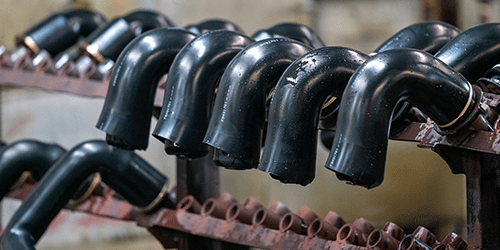Rubber is an amazing material: strong yet soft, pliable and tough, able to stretch and shrink. Like most materials, both natural and synthetic rubber deteriorates over time, caused by exposure to environmental factors like heat, UV radiation, and ozone, as well as contact with fluids such as oil and fuel. This deterioration can degrade the functionality of rubber parts like gaskets, O-rings, washers, and seals, and eventually cause complete component failure.
But different types of rubber are impacted in different ways. This blog post will cover what causes rubber to deteriorate, which types of rubber handle environmental factors better than others, and how to help prevent rubber from deteriorating.
Deterioration is a gradual decline in quality. Rubber deterioration is when natural or synthetic rubber’s properties change, including softness (or hardness), tensile strength, ability to expand after compression, or elongation. This creates conditions where the rubber component’s performance is impaired.
Deterioration is unavoidable. But you can lengthen the life of your rubber components by choosing the right rubber formulation given its usage and environment and making sure you work with a rubber manufacturer that understands the strengths and weaknesses of the many types of natural and synthetic rubber.
The most common factors that cause rubber to deteriorate are:
Let’s cover these factors one by one and list some rubber types that perform better in each.
UV radiation weakens rubber’s molecular structure which decreases its tensile strength. The rubber will lose its elasticity, crack, and become soft. Some of the best rubber types for UV exposure include butyl, EPDM, and neoprene.
High temperatures (200°F and above)
Exposure to high heat can cause rubber to harden (which makes it less flexible and crack), shrink (which impacts sealing ability), and dry out (which leads to cracking and a loss of flexibility). Nitrile is commonly used in temperature environments up to 350ºF; CSM (chlorosulphonated polyethene) offers heat resistance to 250°F; and EPDM (ethylene-propylene-diene monomer) offers heat resistance up to 300°F.
Low temperatures (40°F and below)
Extremely low temperatures cause rubber to soften, which can lead to seal compromise and leakage. EPDM, butyl rubber, natural rubber, and SBR all offer excellent resistance to low temperatures.
Oxidation
Deterioration caused by oxidation can cause rubber to harden or soften, depending on its molecular structure. It’s more common for oxidized rubber to harden because it causes new crosslinks to form, which increases its rigidity and decreases its flexibility. EPDM, butyl rubber, neoprene, CSM, ECO (epichlorohydrin) all offer excellent resistance to oxidation.
Rubber used in industrial and commercial applications may come in contact with many different types of liquids, including acids, alkalis, and petroleum-based products.
Acids
Acids have a pH of less than 7, and pH is the amount of hydrogen ions in the solution. Hydrogen ions can degrade Buna-N and EPDM. Butyl rubber and ECO (epichlorohydrin) perform especially well in the presence of acids.
Alkalis
Alkalis have a pH greater than 7 with many hydroxide ions in the solution. Buna-N rubber is especially vulnerable to alkalis. Neoprene and nitrile rubbers can handle exposure to alkalis.
Petroleum-based products
Petroleum-derived oils and greases contain hydrocarbon components that can dissolve rubber. Buna-N and EPDM can be impacted by petroleum products. Nitrile rubbers are the go-to for exposure to petroleum-based products, but ECO (epichlorohydrin) also does well.
(Please note that this list isn’t exhaustive, and many different variables can have an impact on rubber’s resistance to these factors. Always work with a rubber formulation expert to ensure you use the right rubber for your project.)
You can’t completely prevent rubber deterioration. The best way to minimize rubber deterioration is to identify the correct type of rubber before your project begins to predict its rate of deterioration and plan in advance.
Here are 4 ways to best minimize rubber deterioration for your project:
1. Understand the environment the rubber will be used in
The first step to minimizing rubber deterioration and increasing the lifespan of your rubber components is knowing the environment in which it will operate. Will it be exposed to UV rays? Acids or alkalis? Extreme high or low temperatures?
2. Clearly define how your rubber component must perform
Each type of rubber has different properties, and it is vital to understand them to choose the right rubber for your project. Defining your rubber performance specifications helps your rubber manufacturing partner help you choose the right type for your application.
3. Partner with the right rubber manufacturer
Confirm that your chosen rubber manufacturer understands your project, its specifications, and operating environment so it can create the right rubber component for you.
4. Create the right rubber compound
If you choose the right rubber manufacturer, they may create a custom rubber compound for your project, as defined by your specifications. Rubber compounding mixes components together to create a rubber component that meets your specs and determines the rate at which your rubber will deteriorate.
Rubber manufacturing is a complex business and the final choice of rubber formulation for your project is a team effort with you and your rubber manufacturing partner.
The Sperry & Rice rubber engineers utilize our in-house mixing and testing labs to ensure your rubber component is exactly right – performing for its intended use and environment as specified. We can create your custom rubber components from all the rubber types mentioned in this article and do everything it takes to ensure your project gets from concept to completion – on time and on budget.
Have a project that requires sponge rubber gaskets? Contact us!
